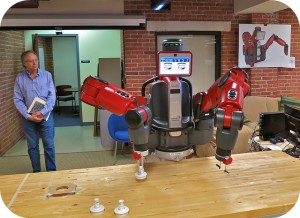 For years manufacturers around the world have taken advantage of the efficiency and speed of robotic labor. But these mechanical monstrosities aren’t polite or funny like the droids in a Star Wars movie. Instead, industrial robots are big, clunky pieces of equipment that have no regard for humans. As a result, most factories have separate rooms for robots that people are prohibited from entering. Many countries have even passed laws requiring the separation of automated and human labor. After all, it only takes one swing of a mighty mechanical arm to maim or even kill an unsuspecting worker.
For years manufacturers around the world have taken advantage of the efficiency and speed of robotic labor. But these mechanical monstrosities aren’t polite or funny like the droids in a Star Wars movie. Instead, industrial robots are big, clunky pieces of equipment that have no regard for humans. As a result, most factories have separate rooms for robots that people are prohibited from entering. Many countries have even passed laws requiring the separation of automated and human labor. After all, it only takes one swing of a mighty mechanical arm to maim or even kill an unsuspecting worker.
Thanks to recent advancements in automation, however, policies like these are increasingly becoming a thing of the past. For instance, many factories are outfitting robots with sensor technology that is similar to collision detection in new cars. This allows them to stop in their tracks if an object or person gets in the way. In fact, the technology is so reliable that some governments are repealing mandates that require fenced-off robot areas. As these barriers disappear, people will start working closely with their robotic counterparts. Experts say that not only does this help factories run faster, but it also makes employees happier, too.
First of all, the new generation of factory robots is far smarter than their forebears. In order to pick up a part, old machines needed the object to be placed in a precise manner or else the robot couldn’t handle it. Today’s adaptive models are much more nimble due to cameras and algorithms that allow the robot to analyze what it is looking at. Innovations like these reduce assembly line bottlenecks and grant workers far more time to accomplish their tasks. What’s more, robots can also perform small, thankless jobs that often frustrate human employees. Most amazingly, though, these modern machines improve every day simply by observing people. Many factories have begun to pair up robots with their highest performing employees so that the machines can learn new techniques. While these same adaptive robots could eventually take their human colleagues’ jobs, for now they are a welcome improvement to a hectic industry.
Questions:
- What other industries could benefit from the use of adaptive robots?
- Will robotic labor eventually replace human labor entirely?
Source: “Smarter, Smaller, Safer Robots,” Harvard Business Review, November 2015. Photo by Steve Jurvetson.
